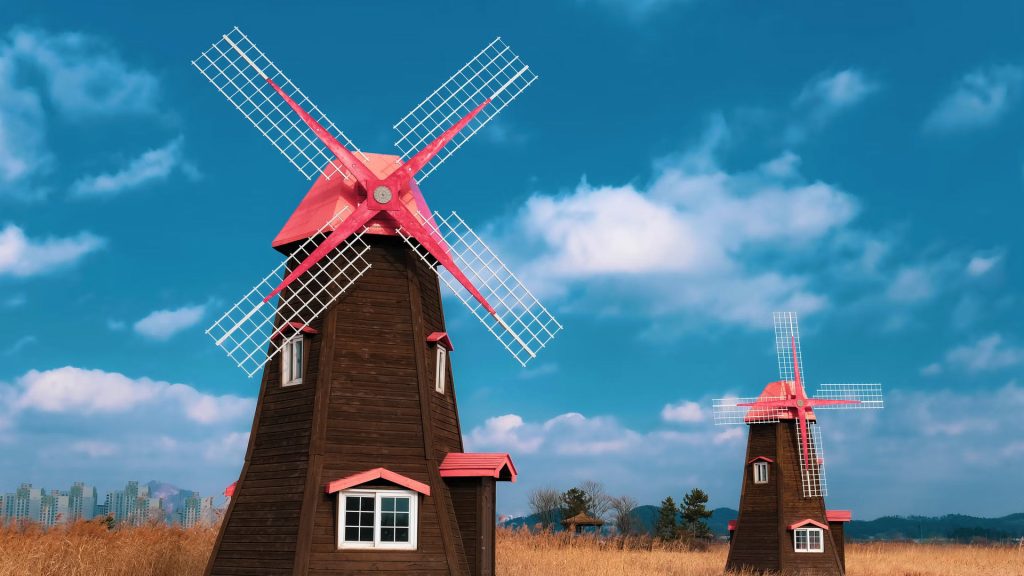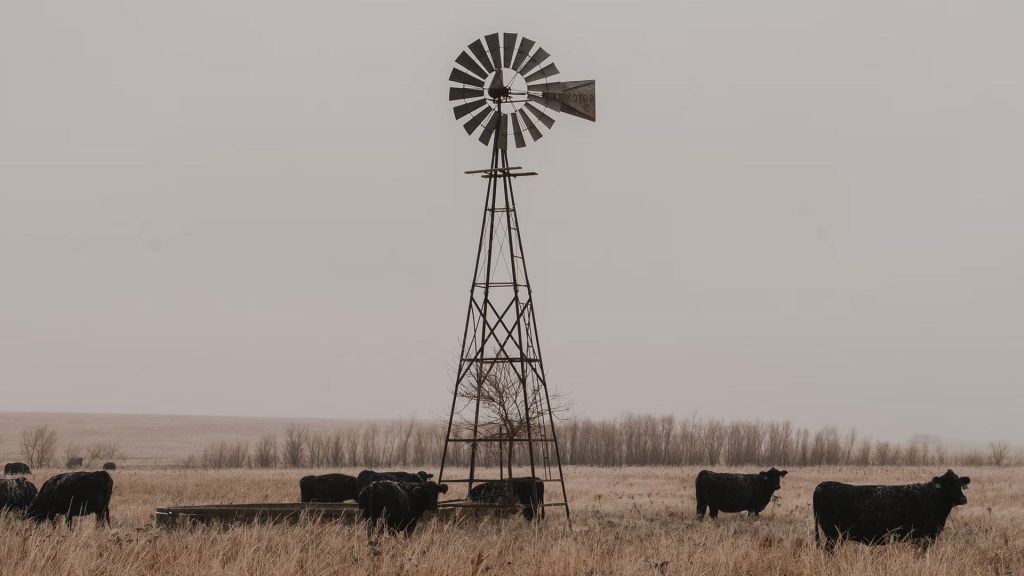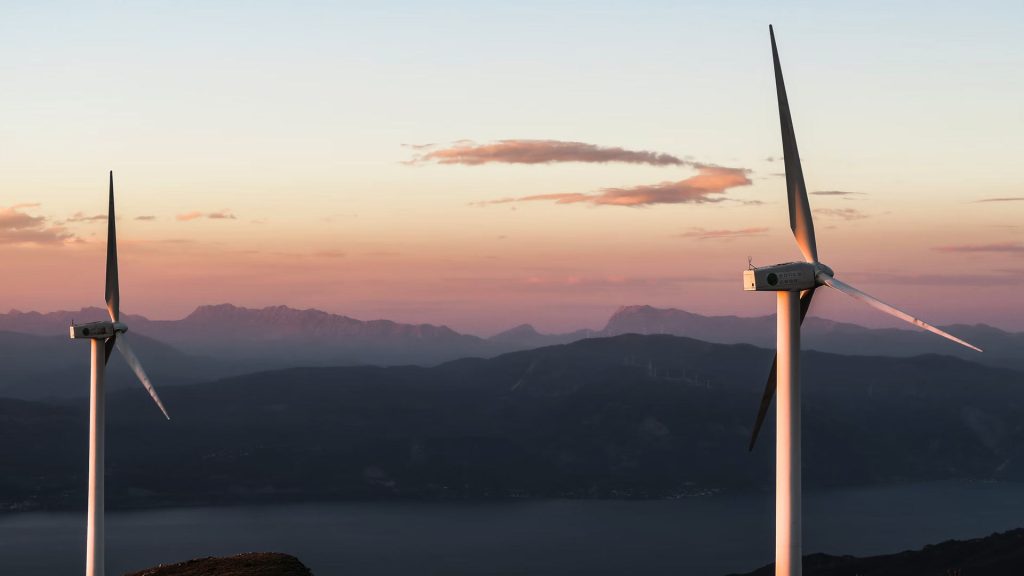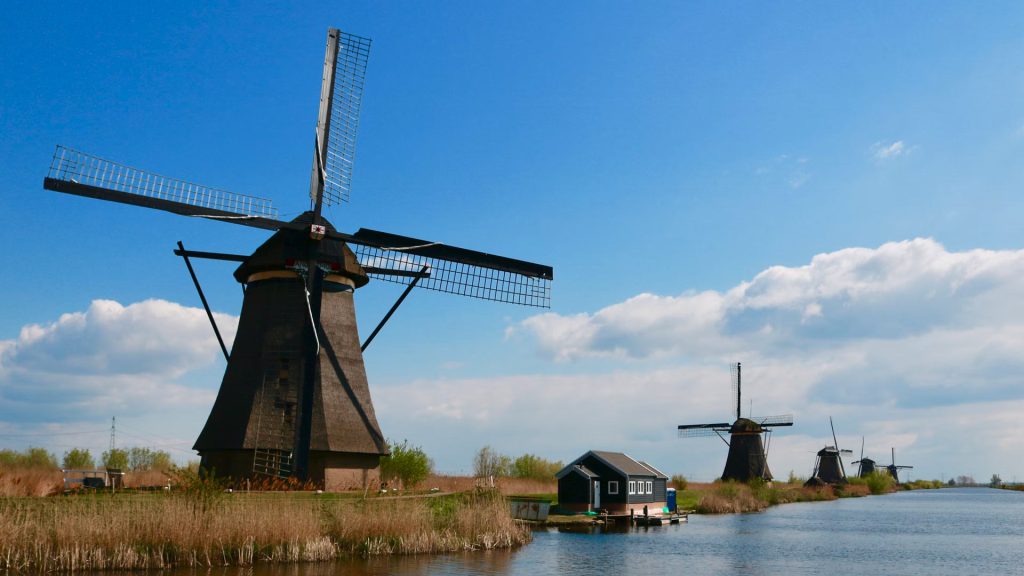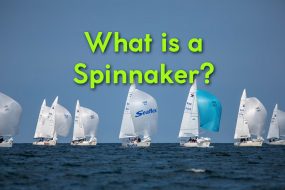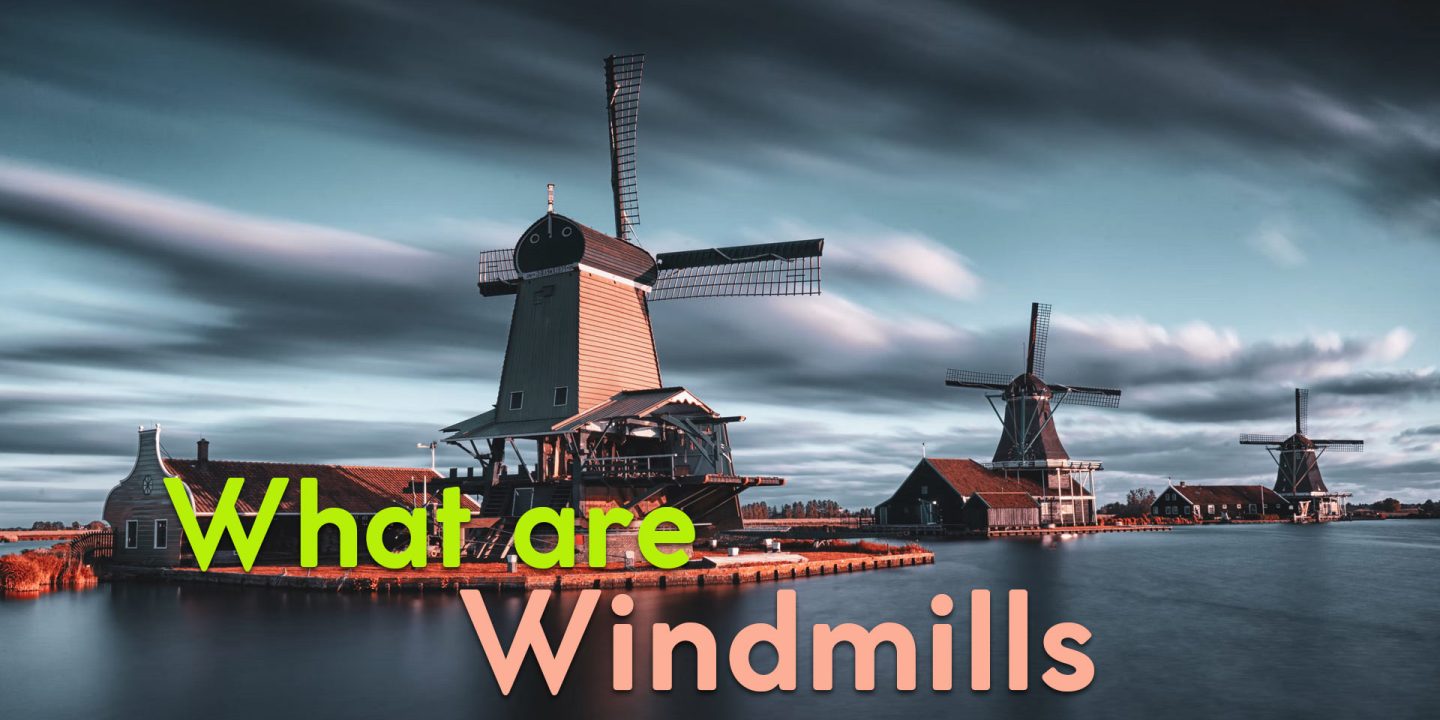
What are Windmills?
As the name suggests, a windmill is a mill that operates on wind power. The working principle is simple – the wind turns the windmill’s blades, which in turn drives a mechanism inside the mill (usually a stone or metal wheel) to grind grain or pump water.
Windmills have been used for centuries and were an important power source for many countries before the industrial revolution. Today, they are mostly used for generating electricity or pumping water, but there are still a few windmills in operation that are used for grinding grain.
There are two main types of a windmill – the horizontal axis windmill and the vertical axis windmill. The horizontal axis windmill is the most common type and has blades that are mounted on a horizontal shaft. The vertical axis windmill has blades that are mounted on a vertical shaft – these are less common but have the advantage of being able to operate in lower winds.
Windmills can be small enough to fit on a roof or large enough to power an entire village. The largest windmill ever built was the Smith-Putnam windmill, which had a diameter of over 100 feet (30 meters).
What is a windmill?
A windmill is a machine that converts wind energy into rotational energy that can be used to power various machines or generate electricity. Windmills have been used for centuries to pump water or grind grain. Today, they are also used to generate electricity.
The windmill blades are turned by the wind, which causes the rotor to rotate. The rotor is connected to a shaft that goes into the nacelle, which is the main body of the windmill. The nacelle contains the gears and machinery that convert the rotational energy of the rotor into usable power.
Windmills can be used to pump water or grind grain. They can also be used to generate electricity. Windmills are becoming increasingly popular as a source of renewable energy.
There are two main types of windmills: the horizontal axis and the vertical axis. Horizontal axis windmills have their blades mounted on a horizontal shaft perpendicular to the ground. Vertical axis windmills have their blades mounted on a vertical shaft parallel to the ground.
The parts of the windmill
The windmill has three main parts: the base, the tower, and the blades. The base is where the windmill stands. It is usually made of concrete or metal. The tower is the part of the windmill that holds the blades. The blades are the part of the windmill that actually catches the wind and turns it into energy.
The history of windmills
Windmills have been used for centuries to pump water or grind grain. The first windmills were developed in Persia and the Middle East. These windmills were horizontal axis windmills. The blades of these windmills were mounted on a horizontal shaft perpendicular to the ground.
The first vertical axis windmills were developed in China. These windmills had their blades mounted on a vertical shaft that was parallel to the ground. Vertical-axis windmills were more efficient than horizontal axis windmills, and they began to replace them in many parts of the world.
Windmills came to Europe in the 12th century. They were first used in Spain and then spread to other parts of Europe. Windmills were used to pump water and grind grain.
The Industrial Revolution saw the development of new types of windmills. These windmills were used to generate electricity. The first power station was built in Scotland in 1887.
Windmills are still used today. They are becoming increasingly popular as a source of renewable energy.
https://www.youtube.com/watch?v=2WBD2_INmgc
When was the first windmill made?
The first windmill is believed to have been built in Persia around the 7th century AD. The design of the Persian windmill was very different from the European windmills that were later developed.
The Persian mill had vertical sails attached to a horizontal shaft, while the European mills had horizontal sails attached to a vertical shaft. The Persian mill was also much larger than the European mills, with a diameter of up to 30 meters.
In the 12th century, windmills were introduced to China, where they were used for irrigation. Windmills continued to be used for a variety of purposes throughout the world into the 21st century.
The first windmill in Europe is thought to have been built in Spain around the 12th century. The Spanish windmills were very similar to the Persian ones, with vertical sails and a horizontal shaft. However, they were smaller, with a diameter of only 10 meters.
The first windmill in England was built in the early 13th century. The English windmills were very different from both the Persian and Spanish ones. They had horizontal sails that were attached to a vertical shaft, and they were much smaller, with a diameter of only 5 meters.
The first windmill in the United States was built in 1854. The American windmill was very different from all of the other ones that had been built before. It had horizontal sails that were attached to a vertical shaft, and it was much larger, with a diameter of 30 meters.
The oldest windmills in the world
There are a number of windmills around the world that have been in operation for centuries. The oldest functioning windmill is thought to be the Tower mill in England, which dates back to the early 13th century. In the Netherlands, there are a number of windmills that have been in use for centuries, including the Zaanse Schans windmill complex which was built in the 16th and 17th centuries. Other ancient windmills can be found in countries such as Spain, Italy, and Greece.
How do windmills work?
Windmills convert the energy of wind into rotational energy that can be used to power various machines or generate electricity. The windmill blades are turned by the wind, which causes the rotor to rotate. The rotor is connected to a shaft that goes into the nacelle, which is the main body of the windmill. The nacelle contains the gears and machinery that convert the rotational energy of the rotor into usable power.
Inside the Windmill
In most traditional windmills, the blades are mounted on a vertical shaft. The inside of the windmill typically contains a large gear wheel, which meshes with a smaller gear wheel attached to the shaft. As the blades rotate, they turn the shaft, which in turn rotates the gears and produces mechanical power. This mechanical power can be used to drive a millstone, pump water, or generate electricity.
The inside of a windmill can be very dangerous because of the rotating blades and gears. For this reason, it is important to take precautions when entering a windmill, such as turning off the power and wearing protective gear.
What are windmills used for
Windmills have been used for centuries to harness the power of the wind. The energy generated by the wind can be used for a variety of tasks, including grinding grain, pumping water, sawing wood, and generating electricity. Windmills are typically located in areas with high winds, such as near mountains or along with coastal areas.
The early windmills were built with a horizontal axis, which meant that the wind turned the blades in a circular motion. This design was later replaced by the more efficient vertical axis windmill, in which the wind turns the blades in a linear motion.
Today, windmills are used primarily to generate electricity. Large wind farms, consisting of hundreds or even thousands of wind turbines, have been built in many countries worldwide. The electricity generated by these wind farms can be used to power homes and businesses. In some cases, the electricity generated by wind farms is even used to supplement traditional power sources, such as coal-fired power plants.
The different types of windmill
There are two main types of windmills: the horizontal axis and the vertical axis. Horizontal axis windmills have their blades mounted on a horizontal shaft perpendicular to the ground. Vertical axis windmills have their blades mounted on a vertical shaft parallel to the ground.
Windmills can also be classified by the way in which they generate electricity. Wind turbines are the most common type of windmill used to generate electricity. These windmills have blades that are connected to a generator. The generator converts the rotational energy of the blades into electricity.
The advantages and disadvantages of windmills
Windmills have several advantages. They are a renewable source of energy, and they do not produce pollution. Windmills are also relatively low maintenance.
There are also some disadvantages to windmills. They can be noisy, and they can be an eyesore. Windmills can also kill birds that fly into them.
The farm windmill
One of the most iconic images of rural America is the farm windmill. Windmills have been used on farms for centuries to pump water or grind grain. Today, they are also used to generate electricity.
The benefits of wind power
Wind power is a renewable source of energy that has many benefits. Wind power is pollution-free, relatively low maintenance, and a renewable energy source. Wind power can also be used to generate electricity.
There are also some disadvantages to wind power. Windmills can be noisy, and they can be an eyesore. Windmills can also kill birds that fly into them.
Overall, wind power is a clean and renewable source of energy that has many benefits.
Windmills today
Windmills are still used today. They are becoming increasingly popular as a source of renewable energy. Wind power is a clean and renewable source of energy that has many benefits.
Read more about Wind Turbines and how they work
About Water Windmills
Wind and watermills are two of the oldest types of energy-producing machines in existence. Windmills have been used for centuries to grind grain and pump water, while water wheels were traditionally used to power mills for crushing ore or grinding flour. Today, wind and water mills are increasingly used to generate electricity.
While wind and water mills share some similarities, there are also some key differences between the two technologies. Windmills are powered by the wind, while watermills are powered by moving water. Windmills can be used to generate electricity directly, while watermills typically power a turbine that in turn generates electricity.
Windmills are more efficient at generating electricity than water mills, but they require a constant wind source to operate. Watermills can be used in areas with less consistent water flows, but they are not as efficient at generating electricity as windmills.
Both wind and water mills have potential drawbacks that need to be considered when deciding which technology to use for generating electricity. Windmills can be noisy and cause visual pollution, while watermills can impact local water supplies.
Overall, wind and water mills are both viable options for generating electricity. The best option for a particular application will depend on the specific circumstances of that location.
The Windmill water pumps
Windmill water pumps are one of the most popular pumps used in agricultural and rural settings. They are often used to pump water from wells or other sources for irrigation, livestock watering, and other purposes.
Windmill pumps work by using the wind to power a rotor, which drives a pump. The pump then moves water from the source to the destination.
There are many different types of windmill water pumps available on the market, so it is crucial to research before purchasing one. It is also important to ensure that the pump you select is appropriate for the specific needs of your farm or ranch.
If you are looking for a windmill water pump for your agricultural or rural needs, keep a few things in mind. First, you need to determine the flow rate that you require. The flow rate will be affected by the depth of the water source, the distance that the water needs to be pumped, and the amount of water that is required.
Next, you need to consider the power source for the pump. Either electricity or wind can power windmill pumps. If you are using an electric pump, you will need to ensure that it is properly grounded and that the wiring is in good condition.
Wind-powered pumps are often less expensive to operate than electric pumps, but they require more maintenance. Windmill pumps that are not properly maintained can be dangerous and may cause property damage or personal injury.
When selecting a windmill water pump, it is important to consider the warranty and return policy. Many companies offer a limited warranty on their products, so you will want to make sure that you understand the terms of the warranty before making your purchase. In addition, you should ask about the return policy in case you are not satisfied with the product.
It is also a good idea to read reviews of different brands of windmill water pumps before making your purchase. This will help you get an idea of which brands are most popular and which ones have the best reputation.
You can find various brands and models of windmill water pumps online. By doing a bit of research, you should be able to find the perfect pump for your needs.
Conclusion of what are Windmills
Windmills are a type of machine that converts the energy of wind into rotational energy that can be used to power various machines or generate electricity. Windmills have a long history and were first used in Spain in the 12th century. There are two main types of windmills: the horizontal axis and the vertical axis. Wind turbines are the most common type of windmill used to generate electricity.
Windmills have several advantages. They are a renewable energy source, and they do not produce pollution. Windmills are also relatively low maintenance. Overall, wind power is a clean and renewable source of energy that has many benefits. Windmills are still used today and are becoming increasingly popular as a source of renewable energy.



